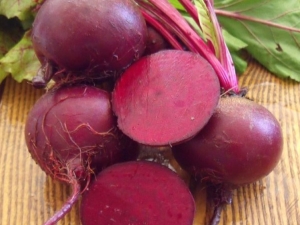Beet "Detroit": description and subtleties of cultivation

Due to the high yield, as well as the presence of excellent taste, beet "Detroit" gained wide popularity among gardeners engaged in planting vegetables on their land plots. It should also be noted the impeccable appearance of the beets of this variety. Our article is devoted to the features and subtleties of the cultivation of this vegetable.
Characteristic variety
Detroit is a high-yielding beet variety. It was obtained as a result of the painstaking work of breeders from Italy. This beet is considered a table species.
Only 100 days takes a period from sowing seeds into the ground until harvesting. This beetroot is excellent for growing both in open field and in greenhouse conditions, however, climate conditions should be taken into account. Beet varieties "Detroit" without special consequences tolerates small frosts. Seedlings sprout well on the surface of the soil after planting, which is carried out before winter. Also, this class is characterized by immunity to the effects of a number of diseases.
Root crops that are harvested from the garden plot, have a rounded shape, and the skin has a very small amount. The flesh is distinguished by an unusually beautiful burgundy color, on which there is no streak or white rings. On average, root weight ranges from 200 grams and above. There are cases when half a ton of root crops, differing from other varieties with excellent taste characteristics, were collected from one hundred of the plot.
Due to the special taste qualities of Detroit beets are in great demand when used fresh, as well as in the manufacture of juices and various preservation. Vegetable growers talk about this, leaving their feedback on specialized forums and websites. Because of the high sugar content (up to a maximum of 14%), as well as dry matter (up to 20%), the roots have excellent keeping quality, while maintaining the full range of vitamins and flavor characteristics.
This variety can be presented in three variations:
- dark red Detroit;
- Detroit 6 Rubidus;
- Detroit 2 Nero.
The first type refers to the early ripening varieties, characterized by the presence of a more rounded root vegetable with a distinct dark red color of the pulp. Rubidus is also considered an early maturing variety, however, it has a slightly aligned root with a thin stem.
Beet species Nero attributed to mid-season varieties. The flesh of root vegetables is painted in burgundy color. This type of beet is well proven for long-term storage.
All of the above types of beet "Detroit" easily grown in climatic zones with adverse conditions.
Advantages and disadvantages
Vegetable has the following advantages:
- high yield;
- resistance to low temperatures;
- unpretentiousness at cultivation;
- uniform germination throughout the landing area;
- resistance to various diseases.
As for the shortcomings, they have no variety. If something can manifest, it is only if non-compliance with any conditions for its favorable growth.
How to grow?
Seed preparation
Beets are grown in the open ground with the help of seedlings or directly from seeds that are sown in specially made rows. Preferring seedlings should provide an optimal set of conditions that will promote the development of the plant, these efforts will not be in vain, because this way you can get an earlier harvest.
There are special rules that must be followed when planting seeds in open ground. Initially, it is necessary to prepare the land with fertilizers, thus creating a nutritional basis. To do this, the autumn digging and simultaneous enrichment of nutrients using organic or mineral fertilizers.
You must choose a sunny place that will be protected from exposure to drafts. You should have information about what was previously grown in this area, because the root crop has poor seedling rates after cabbage or carrots. Beetroot feels great in the beds, where they harvested cucumbers, tomatoes, potatoes or onions last season.
Particular attention should be paid to the choice of soil. If the earth has a high acidity, then you should add previously prepared ashes when planting seeds. You can also use lime, which can reduce acidity.
It is forbidden to plant seeds on the plot, if the earth is not heated over + 13 ° C.Due to the fact that the seeds have a long period of germination, they must first be prepared for planting. You can perform this procedure in several ways:
- soak in water for a day;
- wrap in cloth soaked in potassium permanganate solution.
In the case of warm water, it will be necessary to constantly replace it in order to maintain approximately the same temperature. In the second case, you need to keep the fabric in a warm place and carefully ensure that it remains wet for the entire period. You can also not be zealous with moisture, because you can spoil the seeds.
The prepared seeds grow much faster and with higher quality, in addition, there is an excellent opportunity to collect an earlier harvest. It should be noted that these actions increase the plant immunity to the negative effects of diseases.
Transplant into the ground
After determining the landing site, furrows are formed in the ground, having a depth of up to 3 cm, into which the prepared beet seeds are sown. It is necessary to maintain the distance between the furrows (from 25 cm) and between the seeds (up to 10 cm).
After carefully laying out the seeds, they are powdered with earth, and the beds are mulched. The first shoots may appear on the ground after a week. An interesting fact is the possibility of beet seeds to bond with each other. If these are available, then they do not need to be separated, because this will damage the seed.
Care
After sprouting appeared on the soil surface, time should be given and efforts should be made for the full development of the plants. Experts recommend sticking to a specific set of rules that are designed to preserve the pledged yield.
- In no case should not allow the formation of coma on the surface of the earth: the penetration of nutrients to the plant's root system will be complicated, thereby significantly reducing its growth rate.
- Due to the fact that young plants do not have an established root system, the weeds that will grow in parallel with the seedlings of beets, can drown them. To exclude such effects, it is necessary to carry out permanent weeding.
- We must not forget about watering young shoots. Timely watering significantly accelerates the process of plant development, however, it is necessary to additionally loosen the soil, with which the accumulation of air near the root system is enhanced. It is recommended to water the beets in the afternoon. In the process of ripening of the root is necessary to carry out this procedure more often. A month before the beginning of the collection of root crops should refrain from watering the site.
- The process of loosening the land should be carried out after watering after a day or two. Mulching is done in order to retain moisture, as well as to destroy unwanted weeds.
- Do not forget about feeding young plants. Fertilizers should be applied several times per season, however, recommendations should be maintained and not exceed their number and frequency, because this is fraught with consequences. Overfed roots crack, voids are formed inside them.
In the next video you will find a brief overview of the beet "Detroit F1".




























